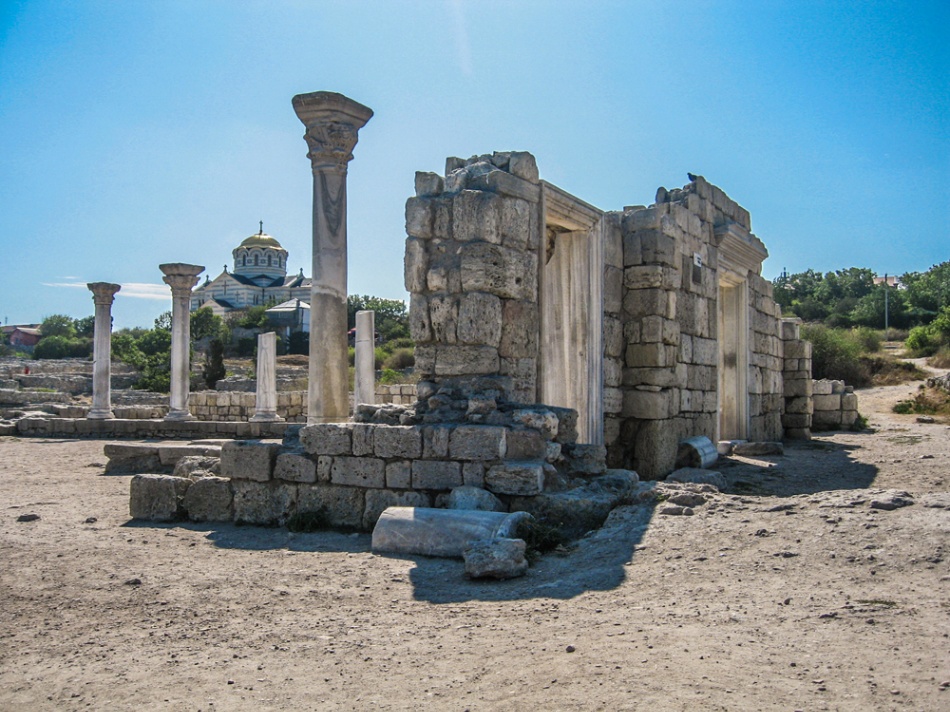Countries<Ukraine<Crimea<Sevastopol< Tauric Chersonese
And in 2013 Chersonese was included in the UNESCO World Heritage List.
Tauric Chersonese is an outstanding testimony to the exchange that took place between the Greek, Roman and Byzantine empires and the population of the Northern Black Sea. Polis and its chora have maintained the role of a centre of exchange of influences and mutual enrichment between cultures for a very long time and with continuity for thousands of years.
Tauric Chersonese and its Chora are a relict agricultural landscape of a huge and well-preserved land allocation system. There are more than 400 flat plots of land around the polis. The remains of walls, fortifications, farmsteads and the characteristic street network reflect the lifestyle of the city's inhabitants and illustrate the use of agriculture and the continuity of the landscape despite subsequent changes in production.
Tauric Chersonese was founded in the 5th century BC by the Dorian Greeks. The name Chersonesus itself means peninsula. On the Heracleian peninsula (southwestern part of Crimea) was founded a polis, which was surrounded by agricultural areas. Over time, Chersonesus became a city-state, which flourished in the 4th-2nd centuries BC. It minted its own coin, and the economy was based on viticulture, fishing, crafts and trade.
From the 2nd century BC Chersonesus was part of the Bosporan kingdom, but after the death of King Mithridates VI Eupator, the city sided with Rome. It was in Roman times that powerful defensive walls were built, the remains of which we see today. Chersonese was a Roman outpost in the Crimea, and it was from Rome that it received Christianity. It happened in the 5th century. Then the ancient temples were demolished to build Christian ones. Then the city became part of the Byzantine Empire.
For a long time, Tauric Chersonese fought against numerous tribes of barbarians who moved to the west. Behind the powerful fortress walls the townspeople felt protected, so the city grew, and by the 11th century it became the largest polis of the Northern Black Sea.
From the 13th century Chersonesus was part of the Empire of Trapezund and Genoa. In 1399, the city was burned down by the Golden Horde Edigei and after that it never recovered as a powerful center of life, trade and crafts. Although the majestic temples and walls of Chersonesus were built so well that they stood until the 19th century, when new barbarians - Russians - came here. The ancient ruins were destroyed with explosives and stretched for building materials. Ancient Chersonese became the basis for the construction of Sevastopol.
А у 2013 році Херсонес було внесено у Список Світової спадщини ЮНЕСКО.
Херсонес Таврійський є видатним свідченням обміну, що відбувався між грецькою, римською і візантійською імперіями і населенням Північного Причорномор’я. Поліс і його хора зберігали роль центру обміну впливами і взаємного збагачення між культурами протягом дуже довгого часу і з безперервністю протягом тисячоліть.
Херсонес Таврійський і його Хора представляють собою реліктовий сільськогосподарський ландшафт величезної і, добре збереженої системи землевідведення. Навколо поліса понад 400 рівних земельних ділянок. Залишки стін, укріплень, садиб та характерної мережі вулиць відображають спосіб життя жителів міста і ілюструють використання сільського господарства та безперервність ландшафту, незважаючи на подальші зміни у виробництві.
Херсонес Таврійський був заснований у 5 столітті до нашої ери дорійськими греками. Сама назва Херсонес означає півострів. На Гераклейському півострові (південно-західна частина Криму) було закладено поліс, який оточили сільськогосподарськими територіями. З часом Херсонес перетворився на місто-державу, розквіт якої припав на 4-2 століття до н.е. Вона чеканила власну монету, а за основу економіки мала виноградарство, рибний промисел, ремесла й торгівлю.
Із 2 століття до нашої ери Херсонес був у складі Боспорського царства, але після смерті царя Мітрідата VI Євпатора місто перейшло на бік Риму. Саме в часи риму було побудовано потужні оборонні мури, залишки яких ми бачимо нині. Херсонес був римським форпостом у Криму, і саме від Риму він отримав християнство. Сталося це в 5 столітті. Тоді знесли античні храми, щоб збудувати християнські. Тоді ж місто увійшло до складу Візантійської імперії.
Тривалий час Херсонес Таврійський вів боротьбу із численними племенами варварів, які рухалися на захід. За потужними фортечними стінами міщани відчували себе захищеними, тому місто розросталося, й до 11 століття перетворилося на найбільш крупний поліс Північного Причорномор’я.
З 13 століття Херсонес був у складі Трапезундської імперії та Генуї. У 1399 році місто спалив темник Золотої Орди Едигей і після цього воно вже не відновилося як потужний центр життя, торгівлі та ремесел. Хоча величні храми та мури Херсонесу були зведені настільки якісно, що стояли до 19 століття, доки сюди не прийшли нові варвари – росіяни. Древні руїни добивалися вибухівкою і розтягувалися на будматеріали. Старовдавній Херсонес став основою для будівництва Севастополя.
